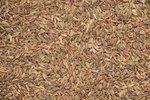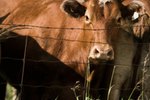
Humans domesticated the horse about 5,500 years ago. Since this time, humans have partnered with horses for food and transportation throughout history. However, only in the past 1,000 years have humans used horses in great numbers for tilling the soil. Horse breeds have changed, too, specializing certain animals for particular jobs.
Early Domestication and Agricultural/Husbandry Use
The evidence of horse domestication and husbandry appears with the Botai peoples who settled the northern steppes in what is modern-day Kazakhstan. Archeological evidence shows that the Botai kept horses for riding, meat and milk. The Botai were semi-sedentary, which would have made it more difficult to follow the migration patterns of wild horses.
Their horses looked more slender and their bone structure was closer to Bronze Age horses than wild horses that lived in the area. Bone evidence suggests the Botai selected traits in their horses and bred for them. The Botai used primitive thong bridles with bits, evidenced by bit wear damage on horses' teeth. Furthermore, pottery found at Botai archeological sites showed that the Botai milked their mares, possibly for an alcoholic drink called "koumiss." Fatty acid analysis shows that the pottery held mares' milk and horse fat, indicative of raising horses for food.
Older Domestication and Husbandry
In the Volga region, horses may have been domesticated as early as 5000 to 4500 BCE for meat, as evidenced by their use in sacrifices along with cattle and sheep. These people buried parts of the horses along with other domesticated livestock, suggesting that these animals were domesticated and not wild. These horses may have been domesticated not only for meat, but for packing as well.
The early horses were pony-sized, about 13 or 14 hands or about 136 to 144 centimeters at the shoulders.
Warfare
Eventually the horse became less of an agricultural animal and more of an animal for riding, chariots, packing and warfare. As people bred the horse for size, the horse became a status-symbol and a weapon of war. By 1000 to 800 BCE, cavalry had replaced the chariot.
Enter the Plow Horse
Before the Norman conquest of England in 1066, people used horses for war, riding and packing. Horses were seldom used for plowing fields; that job was relegated to the ox. After 1066, a shift occurred where horses became preferred for hauling and plowing. Due to taboos on eating horse meat, horses were not seen as food, and thus many had less value than the ox, which could be eaten. Although horses could be expensive, a broken-down nag could be bought cheaply and used for some work. Horses are faster than oxen and more efficient. They became plow horses as well as animals to cart goods.
References
- Science: The Earliest Horse Harnessing and Milking
- Science Daily: Archaeologists Find Earliest Known Domestic Horses: Harnessed and Milked
- Hartwick.edu: Horses and Humans in Antiquity
- History Today: A Quiet Revolution - The Horse in Agriculture, 1100-1500
- Google: Horses, Oxen and Technological Innovation: The Use of Draught animals in English Farming from 1066 to 1500 (Cambridge University Press, 1986)
Photo Credits
-
Hulton Collection/Valueline/Getty Images




